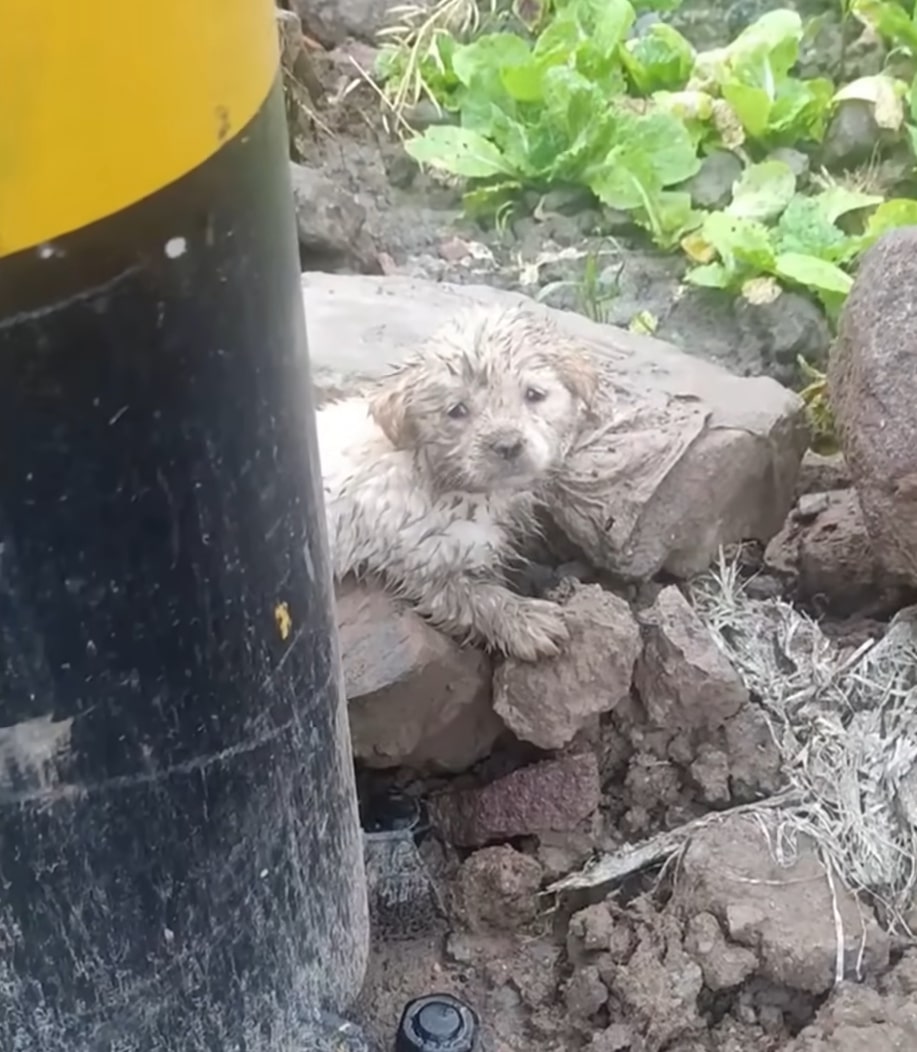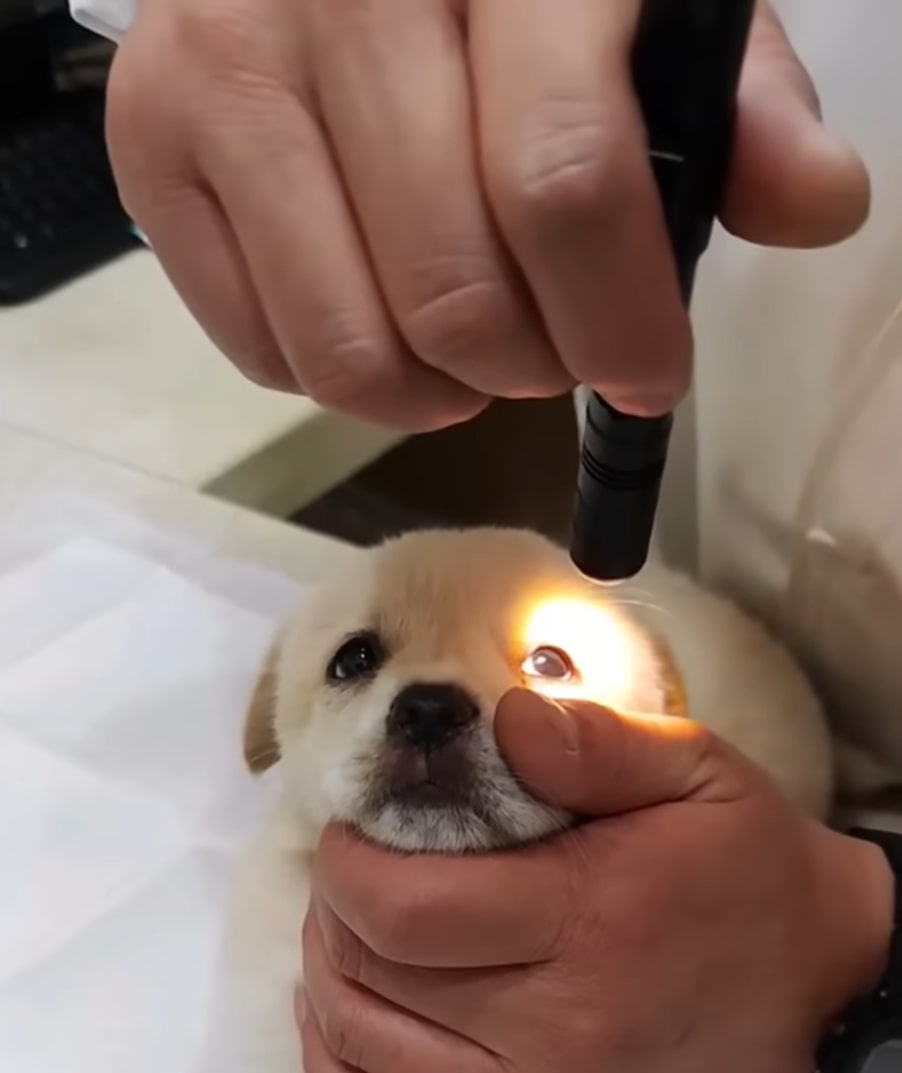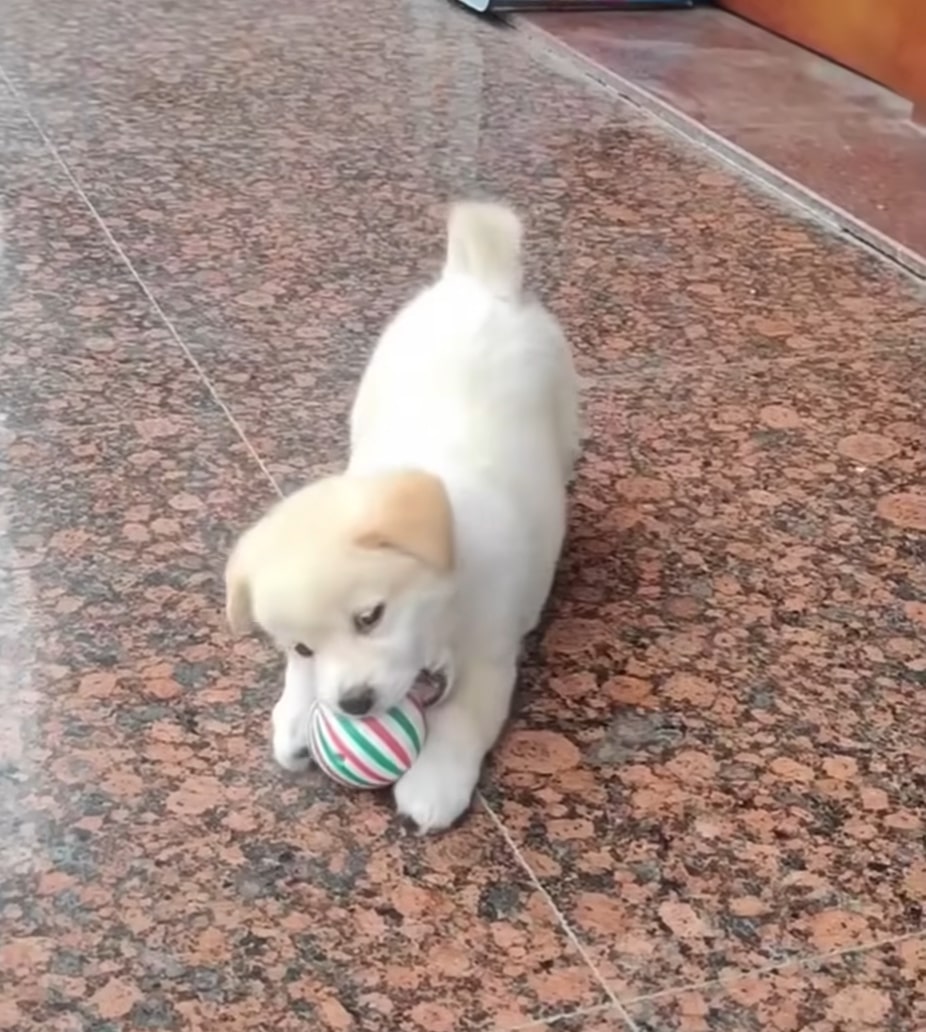It’s truly a heartbreaking sight to see a dog in need fighting for its life.
Sadly, this is the harsh reality for many street canines that are left to fend for themselves. Living in terrible conditions, only a few lucky ones ever succeed in finding their way to a new start.
One heartbroken pup was found in the same situation by a group of kind rescuers. She lived her life on a street, all covered in mud and rain. With no proper shelter above her head, this furry little girl had zero chance to make it on her own.
And, that’s when fate intervened!
Fighting For Life In Inhumane Conditions

This tiny pup stood near a power pole on the street, and she was completely defenseless. There was only a glimmer of hope in her eyes while she tried to preserve her body temperature.
On the exterior, her body was trembling from the cold, all covered in mud from terrible living conditions.

When the group of rescuers stumbled upon her, she immediately gave in. In a way, she somehow knew that from now on, everything would be okay.
And, boi, was she right!
The rescuers immediately took her home, where she got all the care she needed. They first dried her wet coat and made sure to give her something to eat. From what she looked like, the pup seemed extremely emaciated.
The good news was – it only took a couple of hours for her to start fully trusting the new hoomans. She was a natural sweetheart, ready to exhibit all of her affection to the people who saved her from the inevitable.
Incredible Transformation

The next day, the rescuers took the pup to get her coat cleaned up.
Within only a few short hours, she looked completely different. Instead of a girl with a wet, muddy coat, there was now a fluffy princess standing all tall and proud! She dazzled absolutely everyone with her amazing transformation.
And, now she was ready to take on life like the real princess she was!

After her makeover, the dog was taken to the vet. There, she was diagnosed with a few minor wounds on her stomach and back.
Luckily, the injuries weren’t nearly as serious as expected, and the dog safely went back home with her loved ones.
Growing Up Like A Princess

Only three months after she was found, she managed to overcome her past trauma and blossom into a happy, enthusiastic girl who made many friends along the way.
With her new family, her true personality kicked in. Underneath that once muddy fur, there lived a slightly mischievous, lively girl who just loved to take on new adventures with every new day!

Now, she gets to do all that!
She has a family that loves her, brings her toys, and nurtures her social nature all the time! This amazing girl now has a whole community of people who just can’t wait for the day to spend time playing with her.
Once a sad pup hiding near a pole, this sweetheart, today, gets to live the life she always dreamed of!
If your furry companion has been constantly vocalizing with whines and whimpers, you might be wondering what’s behind all that noise. As a seasoned dog trainer, you’ve likely encountered this behavior before. Dogs communicate through various sounds, and whining is one way they express their needs and emotions. Understanding the reasons behind your dog’s excessive whining can help you address the root cause effectively.
When your pup starts whining more than usual, it could signal a range of underlying issues that need your attention. From seeking attention and expressing anxiety to physical discomfort or even boredom, there’s a multitude of reasons why your dog may be vocalizing excessively. As you navigate this common canine behavior, unraveling the mystery behind your dog’s incessant whining can lead to a happier and more harmonious relationship between you and your four-legged friend.
Understanding Dog Whining Behavior
The Language of Whining
Dog whining is your furry friend’s way of communicating with you. It’s how they express their needs and emotions, seeking attention, expressing anxiety, indicating physical discomfort, or showing boredom. By paying attention to the pitch, duration, and intensity of your dog’s whines, you can better understand what they’re trying to tell you. Remember, each whine has a specific message behind it, and deciphering this message can strengthen your bond with your dog.
- Attention-Seeking Whines: Short, high-pitched whines often indicate that your dog wants your focus or affection. It’s their way of saying, “Hey, pay attention to me!”
- Anxiety-Related Whines: Prolonged, low-pitched whines may signal anxiety or stress in your dog. If your dog is displaying this type of whining, creating a calm environment and providing reassurance can help alleviate their worries.
- Whines Due to Physical Discomfort: Sharp, intermittent whines could be a sign that your dog is in pain or discomfort. It’s essential to observe your dog’s body language and consult a vet if you suspect any underlying medical issues.
- Boredom-Induced Whining: Repetitive, monotonous whining might indicate that your dog is bored and in need of mental or physical stimulation. Engaging your dog in interactive play and providing sufficient exercise can help combat their boredom.
Understanding the specific type of whining your dog is exhibiting can guide you in addressing their needs effectively, leading to a happier and more fulfilling relationship between you and your canine companion.
Common Reasons for Excessive Whining
Seeking Attention
When your dog whines persistently, it may be seeking your attention. Dogs are social creatures and crave interaction with their human companions. Excessive whining could be their way of letting you know they want to play, go for a walk, or simply be by your side. Giving them the attention they need can help reduce this behavior.
Expressing Anxiety or Stress
Dogs can experience anxiety and stress, leading to excessive whining. Changes in their environment, loud noises, or being left alone for long periods can trigger this behavior. Understanding what makes your dog anxious and providing reassurance can help alleviate their stress and reduce whining due to anxiety.
Indication of Pain or Discomfort
Whining can also signal that your dog is in pain or discomfort. They may whine if they have an injury, an underlying health issue, or are feeling unwell. It’s essential to observe their body language and behavior for any signs of pain and consult a veterinarian if you suspect they are whining due to physical discomfort.
Hunger or Thirst
If your dog is whining excessively, it could be a sign of hunger or thirst. Dogs rely on their owners to provide them with food and water, and whining may be their way of indicating that they need to be fed or hydrated. Ensuring they have access to fresh water and a balanced diet can help address this type of whining behavior.
Environmental Factors and Changes
New Surroundings and Situations
When your dog is exposed to new surroundings or experiences sudden changes in its environment, it can lead to increased whining. Dogs are creatures of habit and can become anxious or uncomfortable when faced with unfamiliar places, people, or routines. Moving to a new house, introducing new pets, or rearranging furniture can trigger whining as your furry companion tries to adapt. Providing reassurance, comfort, and a familiar environment can help ease your dog’s anxiety in such situations.
Loneliness and Separation Anxiety
Dogs are social animals that thrive on companionship, and being left alone for extended periods can result in loneliness and separation anxiety, leading to excessive whining. Your dog may vocalize its distress when you’re away or isolate itself due to feelings of abandonment. Separation anxiety can manifest through destructive behavior, constant whining, or pacing. To address this issue, gradually accustom your dog to alone time, create a safe space, and establish a routine to alleviate its anxiety and reduce whining episodes.
Health-Related Causes of Whining
When to Consult a Veterinarian
If your furry friend’s whining seems out of the ordinary or excessive, it may be a sign of an underlying health issue. Regular whining, especially when accompanied by other symptoms like lethargy, appetite changes, or unusual behavior, could indicate a health problem. In such cases, it’s crucial to consult a veterinarian to rule out any potential medical issues causing your dog’s distress. Your vet can perform a thorough examination to identify the root cause of the whining and recommend appropriate treatment or management strategies.
Recognizing Signs of Illness
It’s essential to be vigilant about any changes in your dog’s behavior that could signal an illness. Symptoms like persistent whining, loss of appetite, vomiting, diarrhea, excessive panting, or difficulty moving should not be ignored. These signs may indicate various health conditions, ranging from digestive issues and infections to more severe ailments such as arthritis or organ dysfunction. Monitoring your dog’s overall well-being and seeking prompt veterinary attention when you notice concerning symptoms can help address health-related causes of whining and ensure your pet receives the necessary care.
Training and Solutions to Reduce Whining
Positive Reinforcement Techniques
When addressing your dog’s whining behavior, positive reinforcement can be highly effective. Rewarding your dog when they are quiet and calm teaches them that good behavior is more rewarding than whining. Use treats, toys, or praise to reinforce the desired behavior and ignore the whining to avoid unintentionally rewarding it.
Consistency is Key in Training
Consistency in your training approach is crucial to reducing whining in your dog. Establish clear rules and boundaries, and ensure that all family members enforce them consistently. Inconsistencies can confuse your dog and make it harder for them to understand what is expected of them. Stick to a routine and respond to whining in the same way each time to help your dog learn what is acceptable behavior.
Conclusion
Your dog’s whining behavior is a way of communicating their needs and emotions. Understanding the triggers, such as seeking attention or anxiety, is key to addressing the issue. Loneliness and separation anxiety play significant roles, but with the right strategies, you can help your furry friend feel more secure. Remember to consider health-related causes and consult a vet if needed. Training and consistency are vital in reducing whining; positive reinforcement techniques can make a big difference. By taking proactive steps and showing patience, you can strengthen your bond with your dog and create a harmonious living environment for both of you.
Frequently Asked Questions
Why does my dog whine excessively?
Dogs whine excessively to communicate needs and emotions, such as seeking attention, anxiety, discomfort, loneliness, and environmental changes.
How can I reduce my dog’s excessive whining?
To reduce excessive whining, provide attention, comfort, and a consistent routine. Practice positive reinforcement training techniques, consult a vet for health concerns, and address anxiety triggers.
What are common triggers for a dog’s excessive whining?
Common triggers for a dog’s excessive whining include loneliness, separation anxiety, discomfort, seeking attention, and environmental changes.
Should I consult a vet about my dog’s whining behavior?
Yes, consult a vet if your dog’s whining is accompanied by other symptoms or changes in behavior to rule out potential health issues.
How can I strengthen the bond with my dog to reduce whining?
Strengthen the bond with your dog by providing companionship, mental stimulation, exercise, and positive reinforcement training to reduce whining behavior.
[no_toc]

Hey there, I’m Janet Brooks, a dog-loving student from California. I’m all about helping pups in need, especially those without homes. Me and my awesome friends work together to give shelter and love to stray dogs. Oh, and I also write blogs about dogs to share helpful info.